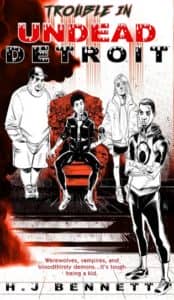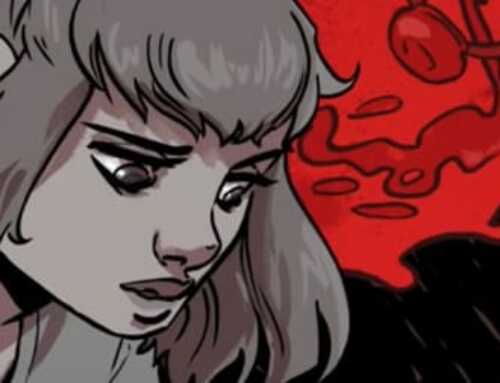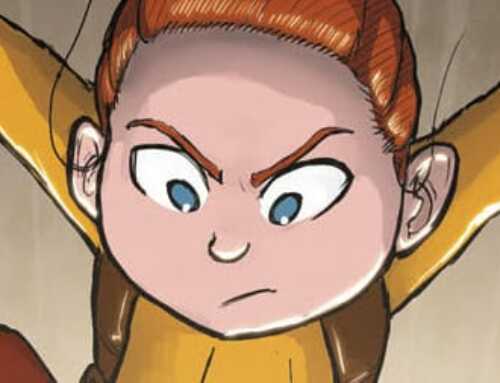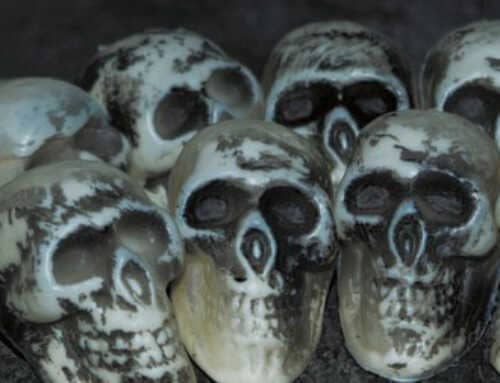Noah  Jackson and his undead orphan cadre find themselves at the center of a government (and potentially celestial) conspiracy in Trouble in Undead Detroit, H.J Bennett’s second novel in the Franken-Fatale universe. The book is written entirely in a journal format, giving us a first-person glimpse into the lives of underprivileged kids in a post-Frankenstein world. We’ve covered the first here, but don’t be alarmed if you aren’t familiar with the original as these are standalone stories. It’s exciting to see Bennett return to the same world as her previous work because this effort is a massive improvement over the previous entry and delivers a lot more on the promising ideas from before.
Jackson and his undead orphan cadre find themselves at the center of a government (and potentially celestial) conspiracy in Trouble in Undead Detroit, H.J Bennett’s second novel in the Franken-Fatale universe. The book is written entirely in a journal format, giving us a first-person glimpse into the lives of underprivileged kids in a post-Frankenstein world. We’ve covered the first here, but don’t be alarmed if you aren’t familiar with the original as these are standalone stories. It’s exciting to see Bennett return to the same world as her previous work because this effort is a massive improvement over the previous entry and delivers a lot more on the promising ideas from before.
Gone are the extremely choppy fragments, the annoying narration tics, and the rampant proofreading errors, plus the choice to write the novel entirely in a diary format renders minor stumbles negligible. This is, after all, the somewhat haphazard record of a 16-year-old. I’ll try to avoid further comparison to the previous book, but keep in mind that if Franken-Fatale didn’t work for you Trouble in Undead Detroit very well may. It’s better in almost every conceivable way, and the author deserves to be commended for that improvement.
Before we go further, there’s a minor elephant in the room to address with Undead Detroit. This novel is extremely topical, dealing with themes of class, race, civil unrest, media distortion, and disenfranchisement. It’s written from the perspective of a Black teen and his peers as they navigate a world of steadily increasing discrimination, albeit due to their post mortem status rather than directly for the color of their skin. While I’m sure some people will find the idea of Bennett writing so far outside of her own experiences distasteful, at no point did the book feel exploitative and the author’s intentions were clearly good. The use of living vs undead discrimination and a growing “life supremacist” movement allows Bennett to approach sensitive topics without directly assuming a set of experiences she hasn’t had. That may not be enough to make it acceptable for everyone, and it’s definitely not up to me to decide, so follow your gut on this one.
The first thing to jump off the page in Trouble in Undead Detroit are the characters– we’re rapidly introduced to Noah and his makeshift family, who are fleshed out well from the get-go and really make the story. There’s growth across the board in some way, shape, or form for all of the main characters, and they each get their own time to shine in the plot. A couple members of the group are also hiding major secrets about the nature of their undead afflictions, and while I would normally admonish a novel with such obvious foreshadowing, in this case it works to reinforce Noah’s naivety. Subtleties like that, coupled with lighthearted banter and stark reality in equal measure, make the cast the highlight.
It’s not all roses though, as the plot could use just a tiny bit of a tune-up. Format considerations aside, the story does still feel very episodic. There’s a lot of ambition here with regards to the scope but getting to the endgame is disjointed. The celestial characters that show up later in the book have adequate motivations but still feel forced and honestly, they’re less infuriating and threatening than the shadowy bureaucrats manipulating the news and causing mass hysteria. The invisible hand that’s causing the majority of the strife in Undead Detroit never really gets its comeuppance, which is fair in its bleak assessment of systemic violence and discrimination but leaves me wondering why the plot moves heaven and earth to create an action movie subplot when that element of the book is easily the weaker of the two.
Recommended for readers looking for creative worldbuilding, strong protagonists, and real-world social commentary.
Rating 8 out of 10 Neck Bolts







